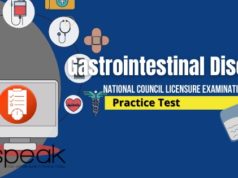Nurses who want to work in the Kingdom of Saudi Arabia need to be able to meet the requirements of the country for professionals who intend to practice there. Apart from the need for experience working in secondary or tertiary level hospitals with certain bed capacities (100- or 200-bed and above depending on the type of facility), nurses also need to pass the examination from the Saudi Council for Health Specialty (SCFHS) which is more commonly known as the Prometric Exam.
The examination aims to assess the nurse’s knowledge, skills, and ability to practice their profession in Saudi Arabia through answering randomly selected multiple-choice questions. 70 questions are normally given to an examinee, administered similar to the NCLEX-RN’s computer-adaptive system. Those who have passed the examination are given a license to practice as nurses in the Kingdom of Saudi Arabia.
This practice test simulates the Saudi Prometric RN examination. Several of the most common topics are included in this set such as:
- Care of patients in emergencies;
- Cardiovascular System;
- Neuromuscular function;
- Medication administration and safety;
- Pediatric assessment; and
- Laboratory values.
Saudi Council Exam for Nurses
1. The nurse anticipates which of the following responses in a client who develops metabolic acidosis.
A. Heart rate of 105 bpm
B. Urinary output of 15 ml
C. Respiratory rate of 30 cpm
D. Temperature of 39 degree Celsius
2. The nurse responder finds a patient unresponsive in his house. Arrange steps for adult CPR.
A. Assess consciousness
B. Give 2 breaths
C. Perform chest compression
D. Check for serious bleeding and shock
E. Open patient’s airway
F. Check breathing
3. An appropriate instruction to be included in the discharge teaching of a patient following a spinal fusion is?
A. Don’t use the stairs
B. Don’t bend at the waist
C. Don’t walk for long hours
D. Swimming should be avoided
4. A nurse is preparing to give an IM injection of Iron Dextran that is irritating to the subcutaneous tissue. To prevent irritation to the tissue, what is the best action to be taken?
A. Apply ice over the injection site
B. Administer drug at a 45-degree angle
C. Use a 24-gauge-needle
D. Use the z-track technique
5. During a basic life support class, the instructor said that blind finger sweeping is not advisable for infants. Which among the following could be the reason?
A. The mouth is still too small
B. The object may be pushed deeper into the throat
C. Sharp fingernails might injure the victim
D. The infant might bite
6. A patient with complaints of chest pain was rushed to the emergency department. Which priority action should the nurse do first?
A. Administer morphine sulfate intravenously
B. Initiate venous access by performing venipuncture
C. Administer oxygen via nasal cannula
D. Complete physical assessment and patient history
7. Several patients from a reported condominium fire incident were rushed to the emergency room. Which should the nurse attend to first?
A. A 15-year-old girl, with burns on the face and chest, reports hoarseness of the voice
B. A 28-year-old man with burns on all extremities
C. A 4-year-old child who is crying inconsolably and reports severe headache
D. A 40-year-old woman with complaints of severe pain on the left thigh
8. A new nurse is administering an enema to a patient. The senior nurse should intervene if the new nurse?
A. Hangs the enema bag 18 inches above the anus
B. Positions the client on the right side
C. Advances the catheter 4 inches into the anal canal
D. Lubricates 4 inches of the catheter tip
9. The client’s ECG tracing shows ventricular tachycardia secondary to low magnesium level. Which of the following electrocardiogram tracing results is consistent with this finding?
A. The appearance of a U wave
B. Shortened ST segment and a widened T wave.
C. Tall, peaked T waves
D. Tall T waves and depressed ST segment
10. The physician is assessing the client’s sensorium by using the Glasgow Coma Scale. Which of the following is true about the Glasgow Coma Scale?
A. If the client does not respond to painful stimuli, the score is 0.
B. A scores lower than 10 indicates that the client is in a coma.
C. A score of 8 indicates that the client is alert and oriented.
D. A score of 4 indicates that the client sustained severe head trauma.
11, Vomiting is one of the most common side effects of chemotherapy. The nurse should be aware of which acid-base imbalance?
A. Ketoacidosis
B. Metabolic acidosis
C. Metabolic alkalosis
D. Respiratory alkalosis
12. The mother of a child with bronchial asthma tells the nurse that the child wants a pet. Which of the following pets is most appropriate?
A. Cat
B. Fish
C. Gerbil
D. Canary
13. A client with a fractured leg has been instructed to ambulate without weight bearing on the affected leg. The nurse evaluates that the client is ambulating correctly if she uses which of the following crutch-walking gaits?
A. Two-point gait
B. Four-point gait
C. Three-point gait
D. Swing-to gait
14. Older adults with known cardiovascular disease must balance which of the following measures for optimum health?
A. Diet, exercise, and medication
B. Stress, hypertension, and pain
C. Mental health, diet, and stress
D. Social events, diet, and smoking
15. A client whose condition remains stable after a myocardial infarction gradually increases his activity. Which of the following conditions should the nurse assess to determine whether the activity is appropriate for the client?
A. Edema
B. Cyanosis
C. Dyspnea
D. Weight loss
16. Which of the following is an adverse effect of vancomycin (Vancocin) and needs to be reported promptly?
A. Vertigo
B. Tinnitus
C. Muscle stiffness
D. Ataxia
17. When performing an otoscopic examination of the tympanic membrane of a 2-year-old child, the nurse should pull the pinna in which of the following directions?
A. Down and back
B. Down and slightly forward
C. Up and back
D. Up and forward
18. A client has his leg immobilized in a long leg cast. Which of the following assessments indicates the early beginning of circulatory impairment?
A. Inability to move toes.
B. Cyanosis of toes.
C. Complaints of cast tightness.
D. Tingling of toes.
19. Which of the following baseline laboratory data should be established before a client is started on tissue plasminogen activator or alteplase recombinant (Activase)?
A. Potassium level
B. Lee-White clotting time
C. Hemoglobin level, hematocrit, and platelet count
D. Blood glucose level
20. The antidote for heparin is:
A. Vitamin K
B. Warfarin (Coumadin)
C. Thrombin
D. Protamine sulfate
21. Which of the following sounds should the nurse expect to hear when percussing a distended bladder?
A. Hyperresonance
B. Tympany
C. Dullness
D. Flatness
22. The nurse observes a darkish blue pigment on the buttocks and back of an African American neonate. Which of the following actions is most appropriate?
A. Ask the obstetrician to assess the child.
B. Assess the child for other areas of cyanosis.
C. Document this observation in the child’s record.
D. Advise the mother that laser therapy is needed.
23. The nurse is caring for a client who has severe burns on the head, neck, trunk, and groin areas. Which position would be most appropriate for preventing contractures?
A. High Fowler’s.
B. Semi-Fowler’s.
C. Prone.
D. Supine.
24. While assessing a 4-day-old neonate delivered at 28 weeks gestation, the nurse cannot elicit the neonate’s Moro reflex, which was present 1 hour after birth. The nurse notifies the physician because this may indicate which of the following?
A. Postnatal asphyxia.
B. Skull fracture.
C. Intracranial hemorrhage.
D. Facial nerve paralysis
25. Which of the following factors can alter tissue tolerance and lead to the development of a pressure ulcer?
A. The client’s age.
B. Exposure to moisture.
C. Presence of hypertension.
D. Smoking.
26. Which of the following types of restraints is best for the nurse to use for a child in the immediate postoperative period after cleft palate repair?
A. Safety jacket.
B. Elbow restraints.
C. Wrist restraints.
D. Body restraints.
27. A client in severe respiratory distress is admitted to the hospital. When assessing the client, the nurse should:
A. Conduct a complete health history.
B. Complete a comprehensive physical examination.
C. Delay assessment until the client’s respiratory distress is resolved.
D. Focus assessment on the respiratory system and distress.
28. A client has had a total hip replacement. Which of the following signs most likely indicates that the hip has dislocated?
A. Abduction of the affected leg.
B. Loosening of the prosthesis.
C. External rotation of the affected leg.
D. Shortening of the affected leg.
29. A 25-year-old has been diagnosed with hypertrophic cardiomyopathy. The nurse should assess
the client for:
A. Angina.
B. Fatigue and shortness of breath.
C. Abdominal pain.
D. Hypertension.
30. What is the priority nursing intervention for a client who is admitted to the emergency department with burns over an estimated 27% of the body surface area?
A. Insert a large-caliber I.V. line.
B. Administer morphine intramuscularly.
C. Establish an airway.
D. Administer tetanus toxoid.









👏👏
hope it will help me for my promwtruc exam soon here in kSA
WHAT IS THE PASSING SCORE?
possible to have like this exam in NHRA Bahrain exam?
Hi! have you taken the NHRA?
It’s very helpful for MOH test
Prometric question and answer